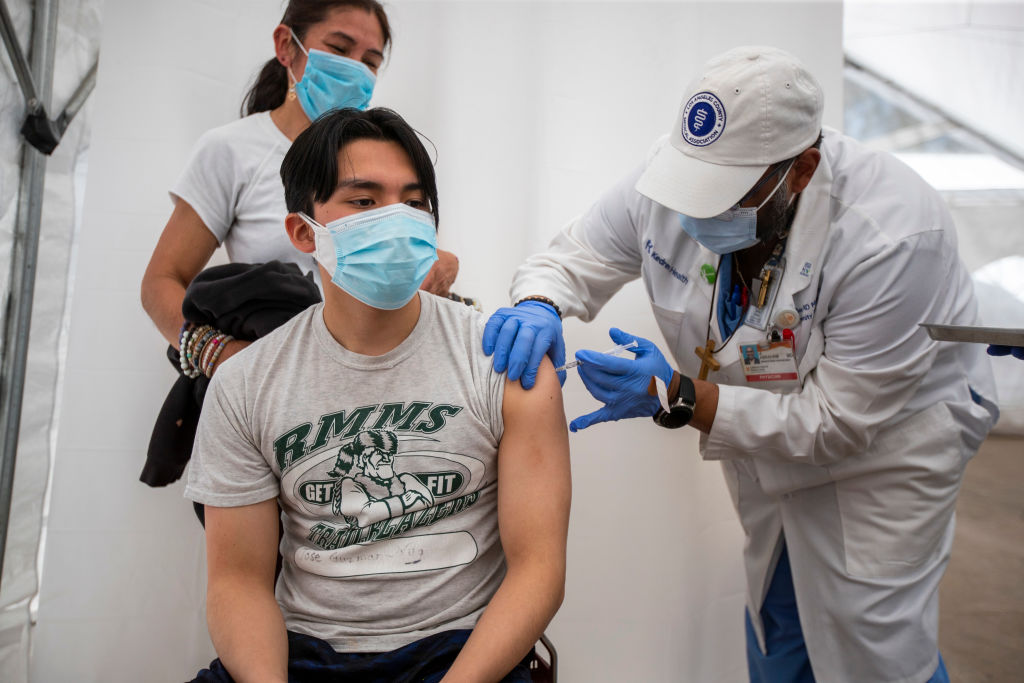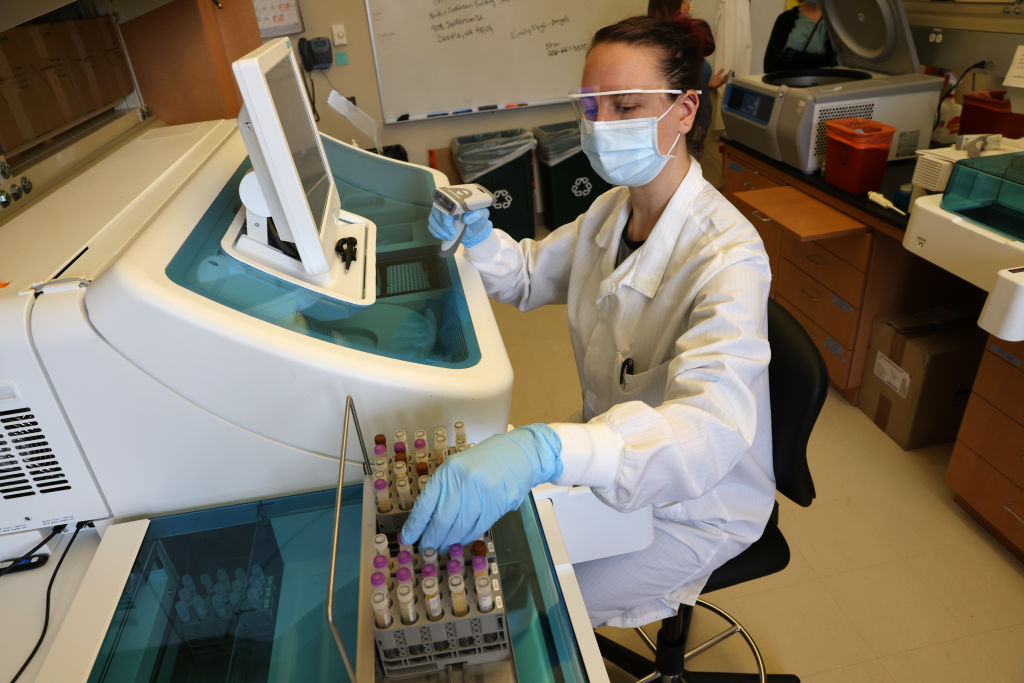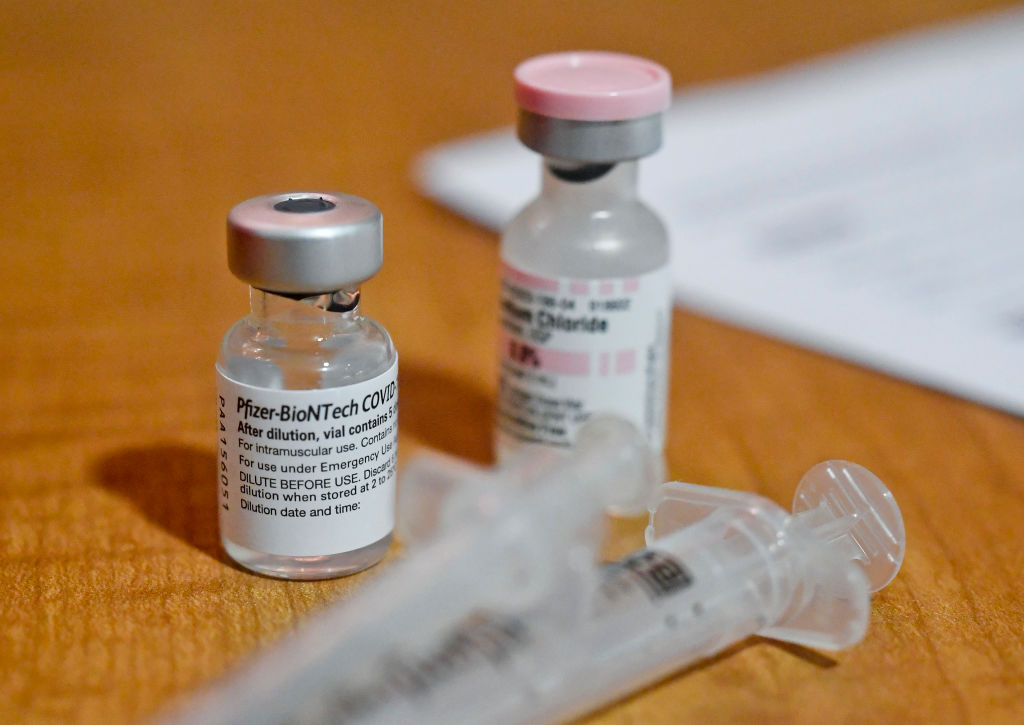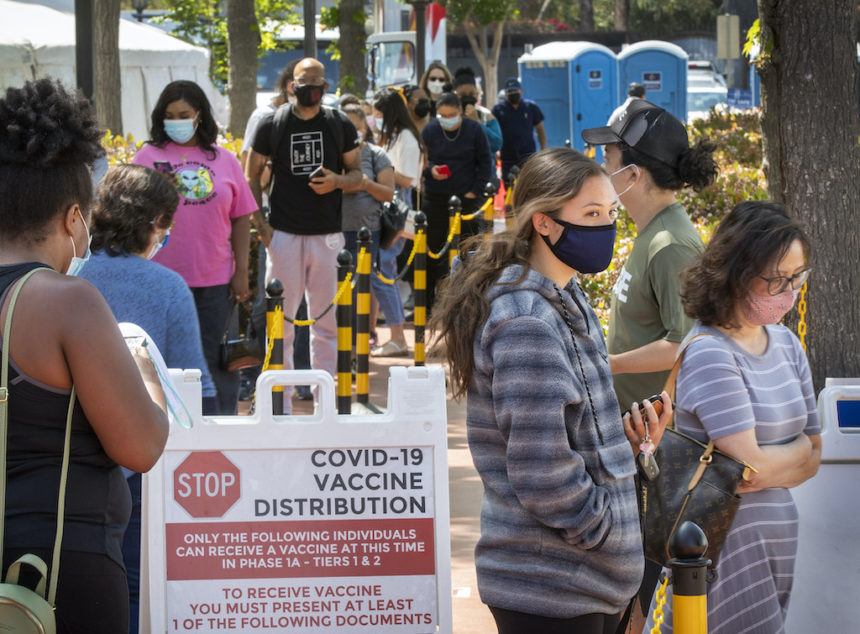As of Monday, 50% of the adult population in the United States had received at least one dose of COVID-19 vaccine, and 33% were fully vaccinated. In another metric milestone, more than 80% of seniors have had at least one shot, and nearly two thirds are fully jabbed.
Now that the (adult) glass is half full, how do we fill it? Four months into the campaign, the initial surge of vaccinations still has momentum, as we’ve averaged more than 3 million shots a day in early April. In pockets of America here and there, however, unused doses are evidence of flattening demand.
At this point, the drive to herd immunity will depend, in large measure, on getting out the “vote” in the distant precincts, the territory occupied by those who watch and wait, those with doubts and fears. Plus, of course, the children.
Monday was a milestone in another respect—the date when all Americans 16 and older became vaccine-eligible. With that impetus, the White House is launching a multichannel media blitz to spread the word near and far. Literally, we’re waiting for the upshot.
This edition of the Vaccine Project Newsletter is 2,838 words long and will take you 9 minutes to read.
Opening shot
By the end of this week, we’ll likely have a recommendation on the use of the J&J vaccine from the CDC’s Advisory Committee on Immunization Practices. The Committee met last week but needed more time as well as more data on severe blood clots and low platelet counts reported in six vaccinated individuals. An emergency meeting of the ACIP will take place Friday from 11 am to 5 pm. As always, stay tuned.
An Axios-Ipsos poll reports that 91% of the public are aware of the pause and 88% of those who are aware think that the CDC and FDA did the responsible thing. The 91% awareness level is considered on a par with, or even a cut above, awareness of who won the Super Bowl.
Based on its own investigation, the European Medicines Agency announced on Tuesday that the blood clot/low platelet combination should be included in the J&J vaccine product information as a “very rare” side effect. The EMA’s safety committee emphasized the importance of prompt recognition of symptoms and treatment by specialists. The agency added that the overall benefits of the vaccine outweigh its risks, clearing the way for a rollout in the 27 countries of the European Union.
The communication effort
Einstein said, “If you can’t explain it simply, you don’t understand it well enough.”
· The White House media blitz will include everything from 80-year-old Anthony Fauci speaking to young people on Snapchat to social media toolkits for 6,000 churches, doctors and other community partners. These are the “trusted local messengers” whose importance grows by the minute.
· The Ad Council and others have developed a variety of methods for gauging the success of vaccination campaigns, Natasha Bach writes in PRWeek. It’s not just a matter of measuring vaccine uptake but also determining attitudes toward vaccination, generally and within specific subpopulations. The Ad Council is partnering with data and tech companies such as Nielsen, Kinetiq and Trade Desk to track ad placements and audience reach.
· The NBC vaccination special, “Roll Up Your Sleeves,” drew 1.4 million viewers Sunday evening with a star-studded cast that included Michelle and Barack Obama, Lin-Manuel Miranda, Matthew McConaughey, Charles Barkley and Shaquille O’Neal. That’s nowhere near the 6 million who watched the Academy of Country Music Awards (which included an Ad Council PSA for COVID-19 vaccination) or the 8 million tuning in to 60 Minutes. But a million is a million.
· Taking the J&J vaccination temporarily out of circulation may have the unintended consequence of making it the vaccine of last resort. That assessment comes from Peter Pitts, former FDA official and cofounder of the Center for Medicine in the Public Interest. Betsy Kim has details in PRWeek.
· Pitts, also quoted in USA Today, said “While targeted public relations and advertising campaigns are important, what will really move the needle (both literally and figuratively) are neighbors talking with friends, neighbors and relatives about their positive experiences and the feeling of freedom” one experiences after vaccination.
· Former FDA Commissioner Scott Gottlieb believes it was prudent to pause the J&J vaccine. He also notes that COVID-19 won’t be eradicated in the way that smallpox was wiped out unless the population demonstrates a massive spirit of “civic virtue” by getting vaccinated.
· Joshua Sharfstein, vice dean for public health practice and community engagement at Johns Hopkins, said people “should have confidence … that the benefit of the vaccine is enormous. There’s no need for this pause to fundamentally change the dynamic.”
· Opinions on the J&J pause diverge like two paths in a yellow wood. It will either fuel vaccine hesitancy or bolster confidence in transparency. Possibly both. Wonder how many “likes” each would get on Facebook. Kimberly Bonvissuto and Kimberly Marselas explore the range of reactions in McKnight’s family of publications.
· The most likely scenario, according to White House chief medical advisor Anthony Fauci, is that the J&J vaccine will be restored to the available vaccine supply with some caveats and limitations.
· Employers can nurture vaccine confidence by “building conviction” among their employees, Diane Eastabrook writes in McKnight’s Home Care Daily. As explained in a 400-page report from McKinsey & Company, “building conviction” requires educating on the facts, inviting relevant experts and community leaders into the conversation, and creating a network of vaccinated “employee ambassadors” to answer questions and share experiences.
· In rural North Carolina, a Baptist pastor who also works as a paramedic is serving as a trusted messenger for COVID-19 vaccine in the community, speaking to individuals and groups about his decision to get vaccinated. As the Boston Globe reports, it’s “the quiet work of locals fighting a tide of misinformation and skepticism among their neighbors and friends that appears to have the best chance at succeeding.”
The Takeaway:
When public health officials act out of “an abundance of caution” in pausing a vaccine, we should not be surprised if some private citizens choose to exercise “an abundance of caution” when it comes to rolling up their sleeves.

The rollout
One blinking yellow light of caution but two steady lights of green.
· The vaccination campaign keeps rolling along with the Pfizer/BioNTech and Moderna vaccines, which together account for 205 million of the 213 million shots given in the U.S. (111 million for Pfizer, 94 million for Moderna). The White House says there is more than enough supply of both to continue the current pace of 3 million shots a day. The U.S. has purchased a total of 600 million doses from the two manufacturers, enough to vaccinate 300 million Americans.
· In its weekly statement interpreting the latest batch of pandemic data, the CDC says that “It’s complicated but the basics still work.” It’s complicated because emergency department visits and hospital admissions are rising among people ages 16 to 64 at a time when the ranks of the vaccinated are growing. Those damn variants are a likely explanation. The basics of disease prevention hold steady: wear a mask, social distance, wash the hands.
· States are getting creative in the vaccine push. Alaska will start offering vaccinations at four airports in June, with a soft rollout at the end of April to gauge interest. Tourists visiting Alaska are welcome to line up for their shots at the airports as cruise ships are not running up north these days. Louisiana has tried everything from brass bands at a 24-hour drive-through to pop-up vaccination clinics at a Buddhist temple, homeless shelters, truck stops and casinos.
· Twice is not enough. Pfizer CEO Albert Bourla says that those of us who received his company’s vaccine can expect to need an additional dose within the next year. Once again, variants are the variable or wild card here. David Kessler, President Biden’s chief science officer, concurs and says the government will gear up for a future booster campaign. Moderna hopes to have a booster by fall.
· How do teens and young adults really feel about getting vaccinated? In a national survey of young people ages 14 to 24, delivered by text message in March, 84% said they had been vaccinated or were willing to be ; 15% expressed no intent to get vaccinated, down from 20% in a previous survey last October. The study was published in the Journal of Adolescent Health.
· New York City has reached a “tipping point” where virtually all of the most avid vaccination seekers (3 million of the 8 million people in the Naked City) have had their shots, Politico reports. Councilman Mark Levine says, “There’s a large group of people out there who are willing to get the vaccine as long as it’s accessible and easy, and the next stage of our work has to shift to reaching them.”
· Montana-based Benefis Health System is mandating COVID-19 vaccination for its 3,300 employees, who have until July 1 to comply. At Houston Methodist, also mandating vaccination, more than 99% of managers got their shots by an April 15 deadline. All 26,000 Houston Methodist employees must be vaccinated by June 7. More than 84% of the HM workforce, and 96% of employed physicians, received at least their first dose by April 15.
· At Edenwald Senior Living in Maryland, four employees left when vaccine was mandated, but there was no mass exodus as some feared, Kimberly Bonvissuto reports in McKnight’s Senior Living. Edenwald President and CEO Mark Beggs noted that residents achieved a 100% vaccination rate: “This is their home. They don’t have the opportunity to leave. I felt it was my obligation to see that [policy] through for them.”
· In a study of 280 nursing homes in the Genesis HealthCare network, facilities that began their COVID-19 vaccination clinics earlier than others (in mid to late December) have had the best results: 5.2 fewer infections per 100 at‐risk residents over a 7-week period, and 5 fewer hospitalizations and/or deaths per 100 infected residents than would have been expected without vaccination. Danielle Brown and Alicia Lasek share details in McKnight’s Long-Term Care News.
The Takeaway:
Objects in motion remain in motion unless an external force imposes change. Another Einstein saying: “Life is like riding a bicycle. To keep your balance, you must keep moving.”

The challenges
Nothing is destined to be simple. Einstein, once more with feeling: “If we knew what it was we were doing, it would not be called research, would it?”
· The federal government is directing $1.7 billion in stimulus money to the detection, surveillance, and mitigation of coronavirus variants, which now represent about half of all infections in the country. The money will be used to expand genomic sequencing, build six research centers for genomic epidemiology and create a national bioinformatics infrastructure.
· Leaving the middle seats vacant on airplanes could reduce the chances of exposure to SARS-CoV-2 by 23% to 57% when compared with full cabin occupancy, the CDC estimates. The calculation does not account for the use of masks, which the CDC recommends for all airline travelers. Actually, the CDC thinks you shouldn’t travel at all if you’re not vaccinated.
· In a state-by-state analysis of the human and economic impact of the pandemic—measured in lives and jobs lost—New York fared the worst overall with high relative numbers of both. The report, by Hamilton Place Strategies, estimates that the U.S. has lost 13 jobs for every COVID-19 death, with the harshest economic effect in states reliant on tourism and hospitality.
· In the Hamilton Place analysis, the states with the highest excess deaths per million were Louisiana, New York, Arizona, Alabama and Mississippi. States with the greatest job loss per million were Hawaii, New York, Nevada, Massachusetts and Vermont. The states that fared best overalIdaho, Utah, and West Virginia.
· Researchers are turning to strategies used in the 2020 presidential election to track and tag anti-vaccination disinformation and misinformation, the journal Nature reports. One coalition, the Virality Project, aims “to detect, analyze, and respond to incidents of COVID-19 vaccine disinformation across online ecosystems, and ultimately mitigate the impact of narratives which would otherwise undermine the public’s confidence.”
The Takeaway:
For every action there is an equal and opposite reaction. Every surge of infection calls for a corresponding surge of vaccination. Every fabrication needs to be volleyed by the facts.

The vaccine dashboard
The spread of a viral disease has made the world a smaller place. The advent of vaccines can make the world a better place.
· Moderna asserts that the preclinical data on its newest vaccine candidates “give us confidence that we can proactively address emerging variants.“ The company promises to update its vaccines as needed “until the pandemic is under control.” Meanwhile, a Moderna trial in adolescents 12-17 years of age is fully enrolled and a trial in children 6 months-11 years is recruiting.
· Let’s not forget about Novavax, quietly moving ahead with its trials and aiming to request emergency use authorization within months. In addition, Novavax is working on a combination COVID-19/flu vaccine and has a head start on Moderna’s intent to do the same.
· Is it possible that mixing and matching different COVID-19 vaccines can produce better results? Researchers at the University of Oxford intend to find out. In a study known as COM-COV, they’re enrolling people 50 and older who have had their first shot. For the second shot, some will receive the same vaccine while others will get a different product. Vaccines in the study include Pfizer/BioNTech, Moderna, AstraZeneca/Oxford, and Novavax.
· The AstraZeneca/Oxford vaccine is moving full speed ahead in India, where 112 million doses have already been given with little fanfare. The Serum Institute of India, which manufactures the AstraZeneca vaccine in that part of the world, is looking to boost monthly capacity from 70 million to 100 million doses.
· India by all accounts is experiencing not just a surge but a vertical spike in infections, accounting for one in three new cases worldwide. With a total population of 1.4 billion, India has 15.6 million COVID-19 cases, second only to the 31.8 million in the U.S. The daily count of global cases is at its highest level ever.
· Ten Democratic senators have asked President Biden to waive patent protections for COVID-19 vaccines so that lower-income countries can gain access to the products. The move is also supported by international medical organizations including Doctors Without Borders, Oxfam, and Partners in Health.
PhRMA is opposed to any infringement on intellectual property, saying “policies that undermine IP protections, such as government seizure of patent protections to let competitors use that patented invention, threaten incentives to develop new treatments and cures.”
· The CDC recommends against a second dose of Pfizer or Moderna vaccine in people who have had an immediate hypersensitivity reaction to the first. However, researchers sharing two case histories suggest that a second shot might be feasible by using a graded dosing protocol in consultation with an allergist. Cassandra Pardini provides helpful clinical details in MPR.
The Takeaway:
More vaccines, new boosters, possible combos on the way. The possibilities and permutations are endless.
Parting shot
The pandemic sabotaged Sarah Studley’s and Brian Horlor’s wedding plans last November. The ceremony went ahead at the courthouse, but the reception was canceled and the dress Studley was planning to wear went unused—until now. She went to her closet, pulled out the white, A-line satin dress with polka-dot tulle, slipped into her open-toe pumps and headed off to Baltimore’s M&T Stadium for her first COVID-19 vaccination.
Studley was inspired by a woman who tweeted a photo of herself in a floor-length sequined gown celebrating her vaccination as the “EVENT OF MY YEAR.” Studley followed suit and brought a morning of smiles to the vaccination crew. “Seize the joy in the moment,” she told the Washington Post. “I’m already brainstorming what I’m going to do for my second dose.”
… and some songs
· Nothing’s Gonna Stop Us Now, Starship
· Ain’t No Stoppin Us Now, McFadden & Whitehead
· On Top of the World, Imagine Dragons
· Hall of Fame, The Script featuring will.i.am
· Never Give Up On a Good Thing, George BensonThat’s a wrap for this edition of the Vaccine Project Newsletter. Thanks for tuning in. See us back here tomorrow with the Haymarket Coronavirus Briefing. Be well.








